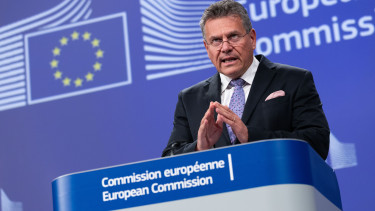Latest EU coronavirus vaccination coverage data show grim situation in Hungary

In September 2023, ECDC updated its COVID-19 vaccination coverage data analysis process, in view of the evolving timing and objective of the 2023–24 season vaccination campaigns. This report presents an interim description of COVID-19 vaccine coverage in the European Union/European Economic Area (EU/EEA) between 1 September 2023 and January 2024.
(In this report, COVID-19 vaccine coverage is defined as the percentage of the target population group that has received one dose of a COVID-19 vaccine during the reporting period. It represents the number of individuals in the total target group who received one vaccine dose during the period under analysis.)
During this period, around 19.4 million people aged 60 years and above received one COVID-19 vaccine dose. Approximately 5.5 million people aged 80 years and above received one COVID-19 vaccine dose.
Among the 24 reporting countries, three countries reported a vaccination coverage ≥50% for the age group 60 years and above, while eight countries reported a vaccination coverage ≥50% for the age group 80 years and above.
Hungary is on the penultimate spot in all three age groups.
The median COVID-19 vaccination coverage among people aged 60 years and above was 11.1% (range: 0.01–65.8%), with high variation among countries.
For people aged 80 years and above, the median coverage was 16.3% (range: 0.01–88.2%), with high variation among countries.
Most of the approximately 22.7 million COVID-19 vaccine doses administered in the EU/EEA during this period in the overall population were the Comirnaty Omicron XBB.1.5 (Pfizer BioNTech) vaccine (around 22 million doses; 97% of the total doses administered).
Across the 24 reporting countries, approximately 22.7 million COVID-19 vaccine doses have been administered during the reporting period among the total population:
- Around 22 million doses (97% of the total doses administered) were the Comirnaty Omicron XBB.1.5 (Pfizer BioNTech) vaccine.
- Around 350 000 doses (1.55% of the total doses administered) were the Nuvaxovid XBB.1.5 (Novavax) vaccine.
- Approximately 56 000 doses (0.25% of the total doses administered) were the Spikevax XBB.1.5 (Moderna) vaccine and
- around 500 doses (<0.01% of the total doses administered) were the Bimervax (Hipra) vaccine.
- Approximately 240 000 doses (1.06% of the total doses administered) were reported as ‘other vaccine product’.
- The remaining administered doses (11 408 doses) were reported as ‘unknown vaccine product’.



Hungarian vaccination specifics
The ECDC has a breakdown of vaccines administered in the EU up to 1 October 2023, i.e. the 39th week of last year. We have taken a closer look at the data, particularly the vaccination coverage of the elderly population.
Here's the vaccination coverage for the entire population:

The highest share of Hungarians protected by Covid shots from severe illness and death (all other variants not considered) are those aged 60 and above, while the percentage of those that received the lowest number of shots relative to the size of their age group is the highest among the youngest. Children first under 12 years and then under 5 years were not cleared to get COVID-19 shots in Hungary, so the percentages were calculated with a population of children aged between 5 and 17, i.e. excluding those in the 0-4 age group.
The following table shows the shares of the vaccinated population by age group and by shots.

According to the latest figures by the Central Statistical Office (KSH), there are over 1.2 million people in the country between 60 and 69 years of age, some 887,000 in the 70-79 and 433,000 aged 80 and over. Altogether there are some 2.5 million people in these three age groups we may consider as elderly. Also, they are those with the highest vaccination rates.
How many people went back for a second, third, fourth ‘helping’?
The following table shows the ‘churn’ at vaccinations. 86.4% to 97.8% of those that got their first jab registered for a second shot (it is not considered a booster, though). As the coronavirus scare dissipated, so did the willingness to get booster shots.
Rather shockingly, only 13.4% of the parents of children aged 5 to 12 signed up for a third dose, although it was only advisable, not strongly recommended, while the highest share was once again recorded in the 70-79 age group at 87.6%. The second, third, fourth, and fifth boosters were clearly less in demand.

Hungary was among the first in Europe to administer coronavirus shots at the end of 2020, second doses were made available in mid-January, and third shots (i.e. the first booster doses) started to be administered on 2 August 2021.
Brief history of the latest vaccination 'campaign'
- According to a state secretary, the cabinet was to buy 700,000 to 800,000 doses of COVID-19 vaccines adapted to the XBB.1.5 Omicron subvariant.
- Local news portal Telex looked into the matter and spotted in the procurement documentation that the order is for 72,000 to 92,000 doses in fact.
- The seller is to be Moderna. The state secretary said that Pfizer had not even made a bid.
- As it turned out Pfizer refrained from bidding not only because it was forced to take Hungary to court for the country’s failure to pay for three million doses of BioNTech-Pfizer’s coronavirus vaccines worth some EUR 60 million, but also because the tender itself was tailored specifically for Moderna’s shot.
- According to our current knowledge, one dose of Moderna's vaccine would be triple of the unit price Hungary would have paid for Pfizer's shots.
- The cabinet refused to take deliver of Pfizer's vaccines citing the war between Ukraine and Russia, and used the very same argument for the rushed procurement of Moderna's Covid jabs.
- XBB.1.5, one of the most closely watched Omicron subvariants was detected in Hungary on 11 September 2023, but authorities somehow 'forgot' to inform the public about this development.
The elderly population and high-risk groups were to be the designated recipients of the new and adapted Moderna vaccine, but - as we saw from the latest ECDC statistics - not many of them requested a shot.
We also looked at how many people aged 60 and over received BioNTech-Pfizer's Comirnaty BA.1 shot that was already adapted to a new Omicron subvariant, although not the XBB.1.5. ComBA.1 has been available in Hungary since 5 September 2022.
Pfizer’s vaccine has been updated over time to target new virus variants. First introduced in December 2020, the original COVID mRNA vaccines from both Pfizer and Moderna protected against the original SARS-CoV-2 virus. They were replaced in September 2022 by “bivalent” vaccines, which targeted both the original virus and Omicron variants BA.4 and BA.5. New updated vaccines in September 2023 replaced the bivalent shots with ones targeting the XBB lineage of the Omicron variant.
The results of a recently published study "provided reassuring evidence that the bivalent BA.1 booster vaccines provide similar protection against hospitalisation with COVID-19 sub-lineages BQ.1, CH.1.1. and XBB.1.5, and that the emergent CH.1.1 and XBB.1.5 sub-lineages do not cause more severe disease than BQ.1."
The charts below show us how many COVID-19 vaccines were administered to those aged 60 and over, as well as the share of their coverage by dose.

These figures might make you say: Not bad, not bad at all. And you would be right. But let's see how many Hungarians aged 60 and over received BioNTech-Pfizer's shot adapted to the BA.1 sublineage, and how their vaccination rate with this particular vaccine looks like.
Comirnaty is also available as three adapted vaccines. Hungary has received only from the first one and is currently in litigation with the producer for cancelling and not paying an order for 3 million doses worth EUR 60 million:
- Comirnaty Original/Omicron BA.1 contains tozinameran and riltozinameran, an mRNA molecule with instructions for producing a protein from the Omicron BA.1 subvariant of SARS-CoV-2;
- Comirnaty Original/Omicron BA.4-5 contains tozinameran and famtozinameran, an mRNA molecule with instructions for producing a protein from the Omicron BA.4 and BA.5 subvariants of SARS-CoV-2;
- Comirnaty Omicron XBB.1.5 contains raxtozinameran, an mRNA molecule with instructions for producing a protein from the Omicron XBB.1.5 subvariant of SARS-CoV-2.
Well, these are not the same scales as above, are they?

The total ignorance Hungarians in general show to Covid shots is perfectly demonstrated by the fact that
the entire ComBA.1 uptake in the six months between 1 April and 1 October was 765 doses.
The ComBA.1 uptake in the entire country was 91,206 doses between 5 September 2022 and 1 October 2023, of which some 61,000 doses were received by people aged 60 and older.
All in all, there's nothing to be surprised about Hungary's extremely poor ranking in the EU's latest vaccination campaign and the dreadfully low vaccination coverage.
Cover photo: Getty Images









